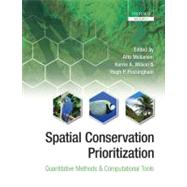
Spatial Conservation Prioritization Quantitative Methods and Computational Tools
by Moilanen, Atte; Wilson, Kerrie A.; Possingham, Hugh-

Free Shipping On Orders Over $35
Your order must be $35 or more to qualify for free economy shipping. Marketplace items, eBooks and apparel do not qualify towards the $35 purchase minimum.
Buy New
Rent Textbook
Used Textbook
We're Sorry
Sold Out
eTextbook
We're Sorry
Not Available
Summary
Author Biography
Atte Moilanen has a background in computer science (MSc 1992), applied mathematics (Licentiate of Technology, Helsinki University of Technology 1998), and spatial ecology (PhD, University Helsinki 1999). Presently (2003-2008) he is a research fellow of the Academy of Finland and vice-director of the Finnish Centre of Excellence in Metapopulation Biology, a leading research group in the study spatial ecology. Atte is also an Associate with the CERF/AEDA Commonwealth funded research hub in applied environmental decision making. Atte is author of more than 40 original publications around the topics of spatial ecology, optimization, and methods for conservation prioritisation. He also is author of multiple pieces of software, including the Zonation package for large-scale conservation prioritisation. Moilanen's present research interests focus on the development of methods, theory and efficient software for application in the field of conservation science. Kerrie Wilson has a background in Environmental Science (BSc, The University of Queensland, BSc, 1999), conservation ecology (PhD, University of Melbourne, 2003), and conservation prioritisation (Post-doc, University of Queensland, 2007). Kerrie was previously the Director of Conservation for the Australia program prior to taking up a senior lectureship at The University of Queensland after being awarded an Australian Research Council fellowship. Kerrie is author of approximately 35 original publications on the topics of spatial conservation prioritisation, threat analysis, and species distribution modelling, including a seminal review on incorporating threats into conservation planning. Her current research interests include the development of frameworks for conservation spending that accounts for threats, costs, ecosystem services, and biodiversity values. Hugh Possingham majored in applied mathematics and biochemistry at The University of Adelaide, followed by a doctorate in biomathematics at Oxford University in 1987. Postdoctoral research periods followed at Stanford University and ANU (as a QEII Fellow). In 1991 he took a Lectureship in Applied Mathematics at the University of Adelaide and was appointed Foundation Chair and Professor of the Department of Environmental Science in 1995. In 2000 Hugh escaped southern Australia to direct The Ecology Centre at The University of Queensland, Brisbane. Hugh is an Australian Research Council Federation Fellow (2006-2010) and a Director of a Commonwealth Environment Research Facility. He has coauthored over 200 publications, 154 in peer-reviewed papers covered by the web of science. His lab includes nine postdoctoral fellows and fourteen PhD students working on empirical and theoretical aspects of biodiversity conservation. In 2005 he was elected to the Australian Academy of Science.
Table of Contents
| Preface | |
| Quantitative Approaches to Spatial Conservation Prioritization: Matching the Solution to the Need | |
| Fundamental Concepts of Spatial Conservation Prioritization | |
| A Mathematical Classification of Conservation Prioritization Problems | |
| Integer Programming Methods for Reserve Selection and Design | |
| Heuristic and Approximate Optimization Methods for Spatial Conservation Prioritization | |
| Conservation Prioritization Using Species Distribution Modelling | |
| Community-level Approaches to Spatial Conservation Prioritization | |
| Conservation Prioritization Using Metapopulation Models | |
| Spatial Population Viability Analysis | |
| Accounting for Habitat Dynamics in Conservation Planning | |
| Conservation Prioritization and Uncertainty in Planning Inputs | |
| Prioritizing Ecosystems, Species, and Sites for Restoration | |
| Climate Change and Spatial Conservation Planning | |
| Marxan and Relatives: Software for Spatial Conservation Prioritization | |
| The Zonation Framework and Software for Conservation Prioritization | |
| The C-Plan Conservation Planning System: Origins, Applications and Possible Futures | |
| The ConsNet Software Platform for Systematic Conservation Planning | |
| From Theory to Practice: Designing and Situating Spatial Prioritization Approaches to Better Implement Conservation Action | |
| Spatial Conservation Prioritization: Past, Present, and Future | |
| References | |
| Index | |
| Table of Contents provided by Publisher. All Rights Reserved. |
An electronic version of this book is available through VitalSource.
This book is viewable on PC, Mac, iPhone, iPad, iPod Touch, and most smartphones.
By purchasing, you will be able to view this book online, as well as download it, for the chosen number of days.
Digital License
You are licensing a digital product for a set duration. Durations are set forth in the product description, with "Lifetime" typically meaning five (5) years of online access and permanent download to a supported device. All licenses are non-transferable.
More details can be found here.
A downloadable version of this book is available through the eCampus Reader or compatible Adobe readers.
Applications are available on iOS, Android, PC, Mac, and Windows Mobile platforms.
Please view the compatibility matrix prior to purchase.
